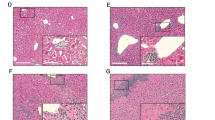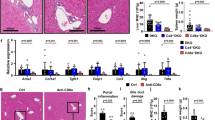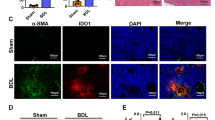Abstract
Liver-resident NK cells are distinct from conventional NK cells and play an important role in the maintenance of liver homeostasis. How liver-resident NK cells participate in autoimmune cholangitis remains unclear. Here, we extensively investigated the impact of NK cells in the pathogenesis of autoimmune cholangitis utilizing the well-established dnTGFβRII cholangitis model, NK cell-deficient (Nfil3−/−) mice, adoptive transfer and in vivo antibody-mediated NK cell depletion. Our data demonstrated that disease progression was associated with a significantly reduced frequency of hepatic NK cells. Depletion of NK cells resulted in exacerbated autoimmune cholangitis in dnTGFβRII mice. We further confirmed that the DX5−CD11chi liver-resident NK cell subset colocalized with CD4+ T cells and inhibited CD4+ T cell proliferation. Gene expression microarray analysis demonstrated that liver-resident NK cells had a distinct gene expression pattern consisting of the increased expression of genes involved in negative regulatory functions in the context of the inflammatory microenvironment.
This is a preview of subscription content, access via your institution
Access options
Subscribe to this journal
Receive 12 digital issues and online access to articles
$119.00 per year
only $9.92 per issue
Buy this article
- Purchase on Springer Link
- Instant access to full article PDF
Prices may be subject to local taxes which are calculated during checkout







Similar content being viewed by others
References
Hirschfield, G. M. & Gershwin, M. E. The immunobiology and pathophysiology of primary biliary cirrhosis. Annu. Rev. Pathol. 8, 303–330 (2013).
Gershwin, M. E. & Mackay, I. R. The causes of primary biliary cirrhosis: convenient and inconvenient truths. Hepatology 47, 737–745 (2008).
Selmi, C. et al. Experimental evidence on the immunopathogenesis of primary biliary cirrhosis. Cell. Mol. Immunol. 7, 1–10 (2010).
Tomiyama, T. et al. The modulation of co-stimulatory molecules by circulating exosomes in primary biliary cirrhosis. Cell. Mol. Immunol. 14, 276–284 (2017).
Chuang, Y. H. et al. Increased killing activity and decreased cytokine production in NK cells in patients with primary biliary cirrhosis. J. Autoimmun. 26, 232–240 (2006).
Gorelik, L. & Flavell, R. A. Abrogation of TGFbeta signaling in T cells leads to spontaneous T cell differentiation and autoimmune disease. Immunity 12, 171–181 (2000).
Oertelt, S. et al. Anti-mitochondrial antibodies and primary biliary cirrhosis in TGF-beta receptor II dominant-negative mice. J. Immunol. 177, 1655–1660 (2006).
Ma, H. D. et al. Chemokine receptor CXCR3 deficiency exacerbates murine autoimmune cholangitis by promoting pathogenic CD8(+) T cell activation. J. Autoimmun. 78, 19–28 (2017).
Yang, G. X. et al. Adoptive transfer of CD8(+) T cells from transforming growth factor beta receptor type II (dominant negative form) induces autoimmune cholangitis in mice. Hepatology 47, 1974–1982 (2008).
Kawata, K. et al. Clonality, activated antigen-specific CD8( + ) T cells, and development of autoimmune cholangitis in dnTGFbetaRII mice. Hepatology 58, 1094–1104 (2013).
Zhang W., et al. Proteomic analysis reveals distinctive protein profiles involved in CD8(+) T cell-mediated murine autoimmune cholangitis. Cell. Mol. Immunol. 15, 756–767 (2018).
Moritoki, Y. et al. B-cell depletion with anti-CD20 ameliorates autoimmune cholangitis but exacerbates colitis in transforming growth factor-beta receptor II dominant negative mice. Hepatology 50, 1893–1903 (2009).
Chuang, Y. H. et al. Natural killer T cells exacerbate liver injury in a transforming growth factor beta receptor II dominant-negative mouse model of primary biliary cirrhosis. Hepatology 47, 571–580 (2008).
Wang, Y. H. et al. Systems biologic analysis of T regulatory cells genetic pathways in murine primary biliary cirrhosis. J. Autoimmun. 59, 26–37 (2015).
Kashiwada, M., Pham, N. L., Pewe, L. L., Harty, J. T. & Rothman, P. B. NFIL3/E4BP4 is a key transcription factor for CD8alpha(+) dendritic cell development. Blood 117, 6193–6197 (2011).
Tian, Z., Chen, Y. & Gao, B. Natural killer cells in liver disease. Hepatology 57, 1654–1662 (2013).
Gao, B. Basic liver immunology. Cell. Mol. Immunol. 13, 265–266 (2016).
Pelletier, S. et al. Increased degranulation of natural killer cells during acute HCV correlates with the magnitude of virus-specific T cell responses. J. Hepatol. 53, 805–816 (2010).
Golden-Mason, L., Cox, A. L., Randall, J. A., Cheng, L. & Rosen, H. R. Increased natural killer cell cytotoxicity and NKp30 expression protects against hepatitis C virus infection in high-risk individuals and inhibits replication in vitro. Hepatology 52, 1581–1589 (2010).
Wen, C. et al. Hepatitis C virus infection downregulates the ligands of the activating receptor NKG2D. Cell. Mol. Immunol. 5, 475–478 (2008).
Dunn, C. et al. Cytokines induced during chronic hepatitis B virus infection promote a pathway for NK cell-mediated liver damage. J. Exp. Med. 204, 667–680 (2007).
Yang Y., et al. Exosomes mediate hepatitis B virus (HBV) transmission and NK-cell dysfunction. Cell. Mol. Immunol. 14, 465–475 (2017)
Peng, H., Wisse, E. & Tian, Z. Liver natural killer cells: subsets and roles in liver immunity. Cell. Mol. Immunol. 13, 328–336 (2016).
Laso, F. J. et al. Chronic alcohol consumption is associated with an increased cytotoxic profile of circulating lymphocytes that may be related with the development of liver injury. Alcohol. Clin. Exp. Res. 34, 876–885 (2010).
Radaeva, S. et al. Natural killer cells ameliorate liver fibrosis by killing activated stellate cells in NKG2D-dependent and tumor necrosis factor-related apoptosis-inducing ligand-dependent manners. Gastroenterology 130, 435–452 (2006).
Kamizono, S. et al. Nfil3/E4bp4 is required for the development and maturation of NK cells in vivo. J. Exp. Med. 206, 2977–2986 (2009).
Male, V. et al. The transcription factor E4bp4/Nfil3 controls commitment to the NK lineage and directly regulates Eomes and Id2 expression. J. Exp. Med. 211, 635–642 (2014).
Peng, H. et al. Liver-resident NK cells confer adaptive immunity in skin-contact inflammation. J. Clin. Invest. 123, 1444–1456 (2013).
Sojka, D. K. et al. Tissue-resident natural killer (NK) cells are cell lineages distinct from thymic and conventional splenic NK cells. eLife 3, e01659 (2014).
Daussy, C. et al. T-bet and Eomes instruct the development of two distinct natural killer cell lineages in the liver and in the bone marrow. J. Exp. Med. 211, 563–577 (2014).
Shimoda, S. et al. Interaction between Toll-like receptors and natural killer cells in the destruction of bile ducts in primary biliary cirrhosis. Hepatology 53, 1270–1281 (2011).
Gao, B. & Bertola, A. Natural killer cells take two tolls to destruct bile ducts. Hepatology 53, 1076–1079 (2011).
Tian, Z., Gershwin, M. E. & Zhang, C. Regulatory NK cells in autoimmune disease. J. Autoimmun. 39, 206–215 (2012).
Fontenot, J. D. et al. Regulatory T cell lineage specification by the forkhead transcription factor foxp3. Immunity 22, 329–341 (2005).
Li, L. et al. Natural killer cells-produced IFN-gamma improves bone marrow-derived hepatocytes regeneration in murine liver failure model. Sci. Rep. 5, 13687 (2015).
Chen, D. et al. Characterization and application of monoclonal antibodies against Mycoplasma hyorhinis pyruvate dehydrogenase E1 complex subunit alpha. Appl. Microbiol. Biotechnol. 100, 3587–3597 (2016).
Yang, W. et al. Differential modulation by IL−17A of Cholangitis versus Colitis in IL-2Ralpha deleted mice. PLoS ONE 9, e105351 (2014).
Yao, Y. et al. Distinct from its canonical effects, deletion of IL-12p40 induces cholangitis and fibrosis in interleukin-2Ralpha(−/−) mice. J. Autoimmun. 51, 99–108 (2014).
Talwalkar, J. A., Souto, E., Jorgensen, R. A. & Lindor, K. D. Natural history of pruritus in primary biliary cirrhosis. Clin. Gastroenterol. Hepatol. 1, 297–302 (2003).
Gershwin, M. E., Mackay, I. R., Sturgess, A. & Coppel, R. L. Identification and specificity of a cDNA encoding the 70 kd mitochondrial antigen recognized in primary biliary cirrhosis. J. Immunol. 138, 3525–3531 (1987).
Zhang, L. H., Shin, J. H., Haggadone, M. D. & Sunwoo, J. B. The aryl hydrocarbon receptor is required for the maintenance of liver-resident natural killer cells. J. Exp. Med. 213, 2249–2257 (2016).
Melhem, A. et al. Anti-fibrotic activity of NK cells in experimental liver injury through killing of activated HSC. J. Hepatol. 45, 60–71 (2006).
Cheng, C. W. et al. NK cells suppress experimental cholestatic liver injury by an interleukin-6-mediated, Kupffer cell-dependent mechanism. J. Hepatol. 54, 746–752 (2011).
Wang, J. et al. Poly I:C prevents T cell-mediated hepatitis via an NK-dependent mechanism. J. Hepatol. 44, 446–454 (2006).
Shi, F. D., Ljunggren, H. G., La Cava, A. & Van Kaer, L. Organ-specific features of natural killer cells. Nat. Rev. Immunol. 11, 658–671 (2011).
He, Y. & Tian, Z. NK cell education via nonclassical MHC and non-MHC ligands. Cell. Mol. Immunol. 14, 321–330 (2017).
Bern M. D., et al. Inducible down-regulation of MHC class I results in natural killer cell tolerance. J. Exp. Med. 216, 99–116 (2019).
Acknowledgements
This study was supported by the Program for Guangdong Introducing Innovative and Entrepreneurial Teams (2017ZT07S054), the National Natural Science Foundation of China (81601416, 81430034, 91542123), the National Key R&D Program of China (2017YFA0205600) and a National Institutes of Health grant (DK090019).
Author information
Authors and Affiliations
Corresponding authors
Ethics declarations
Competing interests
The authors declare no competing interests.
Additional information
Publisher’s note: Springer Nature remains neutral with regard to jurisdictional claims in published maps and institutional affiliations.
Supplementary information
Rights and permissions
About this article
Cite this article
Zhao, ZB., Lu, FT., Ma, HD. et al. Liver-resident NK cells suppress autoimmune cholangitis and limit the proliferation of CD4+ T cells. Cell Mol Immunol 17, 178–189 (2020). https://doi.org/10.1038/s41423-019-0199-z
Received:
Accepted:
Published:
Issue Date:
DOI: https://doi.org/10.1038/s41423-019-0199-z
Key words
This article is cited by
-
Animal models of primary biliary cholangitis: status and challenges
Cell & Bioscience (2023)
-
Innate lymphocytes: pathogenesis and therapeutic targets of liver diseases and cancer
Cellular & Molecular Immunology (2021)
-
Natural killer cells in cancer biology and therapy
Molecular Cancer (2020)
-
Animal Models of Autoimmune Liver Diseases: a Comprehensive Review
Clinical Reviews in Allergy & Immunology (2020)
-
CD49a+CD49b+ NK cells induced by viral infection reflect an activated state of conventional NK cells
Science China Life Sciences (2020)



